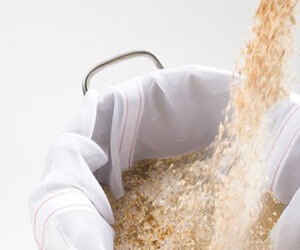20 Tips for New Brewers

Looking for some expert advice to get your first homebrews off the ground and into the fermenter? We asked our extended family of homebrewing suppliers for some advice on how to make those first few batches as good as they can be.
Cleanliness
•Always be clean. Everything on the planet likes beer as much as we do. Everything you read about cleanliness is true.
Jim Leverentz
Leeners You-Make-Kit Brand
Northfield, Ohio
•Cheap vodka makes a great sanitizer. Use vodka in your airlock instead of water. If any pesky little critters try to get to your bubbly barley concoction, they are killed instantly! Keep some in a small mist-style spray bottle and use it to spray the opening of your carboy before pitching your yeast. Keep the spray bottle handy for those times when you need some sanitizer, but don’t have the time to mix up a fresh batch.
Francie Lengerich
The Brewers Art Supply
Fort Wayne, Indiana
•I’d recommend staying away from bleach to clean or sanitize brew equipment. There is a chemical reaction that occurs with the chlorine and maltose molecules that gives off nasty flavors. Bleach doesn’t always rinse out that well and even a little bit can ruin a batch of otherwise great brew. With all the available cleaners and sanitizers on the market, those new to homebrewing should not have to rely on household bleach for the task.
Bob Bacolas
Grains Beans & Things
Medford, Oregon
•The best way to sanitize all your bottles at once, is to grab a large cooler – like what you would take to a tailgate party, because most larger sized coolers hold at least two cases of beer bottles. Place the cooler on the counter with the drain plug facing the sink, and fill with 5 to 7 gallons (19 to 26 L) of water along with some no-rinse sanitizer. Submerge the bottles upright and hold them under water until they stop trying to float to the surface. Double check that the bottles are completely submerged. You may need to add more H2O and sanitizer to get larger sized bottles submerged. Let them soak until you are ready to bottle, and when you are done with bottling just open the drain plug to drain.
Francie Lengerich
The Brewers Art Supply
Fort Wayne, Indiana
Record Keeping and Research
•Keep a brew log, no matter how simple the recipe. This gives you the opportunity to tweak a recipe to get it perfect, as you know what you used and how you used it. Assign each beer with a code that you can write with a permanent marker on the cap and write the code and a brief description on an index page in the front of the log for easy reference. This makes it quick and easy to differentiate your beers without having to mess with labels. If you have a beer fridge, make a copy of the index page and hang it on the fridge with a magnet.
Francie Lengerich
The Brewers Art Supply
Fort Wayne, Indiana
•Don’t get carried away reading absolutely everything you can find about beer or wine making on the Internet. You will get overwhelmed and talk yourself right out of the hobby.
Paul and Carolyn Baker
The Shady Lady
Pensacola, Florida
Ingredients
•A classic beginner’s mistake is heavy-handed use of specialty malts, especially crystal. Too much isn’t always better than not enough. Caramel malts generally shouldn’t exceed 5% of the grist. If you are extract brewing, consider 7.5 lbs. (3.40 kg) of pale malt extract to be about 10 lbs.
(4.53 kg) of pale malt when adding up the grist. When using roasted malts one type is usually enough. Too many colors make grey, too many types of specialties make blah. When tweaking your beer it’s easier to add to a simple recipe than to subtract from a complicated one. And when you do, rely on your nose and your taste buds, not your computer program.
Dan Small
Dan’s Homebrewing Supplies
Vancouver, British Columbia
•I have had many first-time brewers come in with complaints of over-bittered beer. After some questioning I find that they simply misunderstood how to read a recipe. Hop boil times in a recipe read: 60 min., 15 min., 1 min. A first time brewer reads this as a 76 min total boil, however these are the points during the boil when you should add the hops, not the total boil time. Be sure you understand the hop additions when reading recipes.
Doug Kimpel
Just Brew It!
Fayetteville, Georgia
•The best advice I have for beginning homebrewers is to pay just as much attention to fermentation and yeast as the ingredients or
type of beer. Many new homebrewers want to brew a lager beer on their first brew which requires advanced brewing procedures, so I usually recommend using a Kölsch yeast like White Labs WLP029 German Ale/Kölsch to produce a clean, lager-like beer at ale temperatures.
Alex Buerckholtz
Hops & Vines
West Asheville, North Carolina
Fermentation and Temperature Control
•Never rely on airlock activity because it doesn’t tell you much about fermentation. Always use your hydrometer to monitor fermentation. Use the airlock activity as a gauge but not an end-all, be-all tool for fermentation. If you pitch your yeast and don’t see activity in your airlock after a day, it doesn’t mean the beer is not fermenting. It could mean that there is a leak somewhere in the lid, gasket or rubber stopper. During fermentation there is a lot of CO2 produced and some is absorbed into the wort. Because of this you could potentially still have airlock activity after fermentation is complete and that activity is nothing but residual CO2 being released.
Ben Knoerdel
Ben’s Homebrew
Tarentum, Pennsylvania
•Living on the Gulf Coast, we are always fighting warm to hot fermentation temperatures. Our better-established, experienced homebrewers simply buy a thermostat and relegate their fermentation to an ugly avocado green or harvest gold refrigerator, which can maintain very precise fermentation and maturation temperatures. This is beyond the scope of most beginning homebrewers as it is quite an investment in money and space for someone just sticking their toe in the water. The way to get around it is placing the fermenter in a bath of water (sink, spare bathtub, bus tub, galvanized steel tub, picnic cooler, etc.). Keep a few half liter or liter PET soda bottles 80% full of water and toss them into the freezer. Depending on the temperature of the room and the desired temperature for the wort, toss one or two of the bottles into the cooling bath once or twice a day. Wrap your fermenter with an old towel, t-shirt or blanket and you can maintain very reasonable temperatures.
Scott Birdwell
DeFalco’s Home Wine & Beer Supplies
Houston, Texas
Boiling and Steeping
•Bend a paper clip into an “S” shape and pin one end through the top of your grain bag so that you can hang it over the top edge of your brew kettle during the steeping phase of extract or partial mash recipes.
John “JB” Brack
Austin Homebrew Supply
Austin, Texas
•Boilovers are a common beginner problem and can be the cause of domestic problems. They usually happen just before the wort starts to boil. An insulative foam forms on the wort’s surface that allows the liquid to superheat a bit, which can cause a boilover. Should this occur, a quick dash of cold water will bring the boilover to a halt. Always have a small glass of water nearby. A rolling boil does not usually get out of hand. Stirring until this is achieved should not take long.
Dan Listermann
Listermann Manufacturing
Cincinnati, Ohio
Chilling
•When wort chilling, hook up the garden hoses to the wort chiller before you place it into the boiling kettle. This prevents steam from hitting your face and avoids dirty water from leaking or spraying into your kettle.
Nancy Vineyard
The Beverage People
Santa Rosa, California
•To cool partial boils, a lot of books say to mix the boiling wort in the fermenter and then add the cold water. This is thermodynamically backwards and makes reaching pitching temperatures difficult. A far better way is to recognize that in the boiling pot, you have a high temperature differential, a small thermal mass and a conductive container as opposed to trying to cool a plastic bucket filled to five gallons (19 L) of 115 °F (46 °C) wort which can take hours to cool. Just place the pot in a sink of cold water and stir it a bit, changing the water as it heats. After about 30 minutes it will be at body temperature and can be mixed with your cold water in the fermenter, instantly bring it to pitching temperature.
Dan Listermann
Listermann Manufacturing
Cincinnati, Ohio
Follow Procedure and Get Feedback
•If your goal as a new brewer is to try and perfect the process and monitor your brewing results, try making the same recipe or kit over and over again and taste each batch relative to the other. Take copious notes as you brew each batch so you document what you have done differently. As you learn more substitute one ingredient at a time, such as hops or yeast, to notice subtle differences. Brewing the same recipe using different yeast varieties can help you understand their fermentation and flavor characteristics.
Erik Schmid
The Brewmeister
Folsom, California
•In 6,000 years of homebrewing, all the short cuts have been figured out. Follow the instructions.
Jim Leverentz
Leeners You-Make-Kit Brand
Northfield, Ohio
•Get a good opinion. Giving your friends free beer and then
asking them what they think about it is not the best way of having your beer critically evaluated.
Byron Burch
The Beverage People
Santa Rosa, California
Bottling
•When using a bottle filler without a spring in the tip, put a wooden spoon under your bottling bucket with the handle sticking out over the edge of the counter. Loop the hose over it, hanging the filler in the “off” position while capping a few bottles or getting a new case.
Bob Peak
The Beverage People
Santa Rosa, California
•If using a bucket for a primary or secondary fermenter, or for bottling, opt for installing or buying one with a spigot mounted at the bottom to avoid having to siphon your beer.
Erik Schmid
The Brewmeister
Folsom, California
BYO Bonus Tip: Keep Oxygen Away
•Yeast need oxygen when they are pitched in order to grow and ferment the wort properly. However, after they have been “fed,” you should strive to minimize your wort or beer’s exposure to oxygen. Exposure to oxygen while beer ages leads to papery or cardboard-like aromas in beer. And, the presence of oxygen can spur the growth of some beer-spoiling organisms, like Acetobacter, which causes a vinegar-like character in beer contaminated with it. Keep your buckets sealed and fermentation locks filled, rack your beer quietly and use a container without a lot of headspace for conditioning your beer.
Chris Colby



